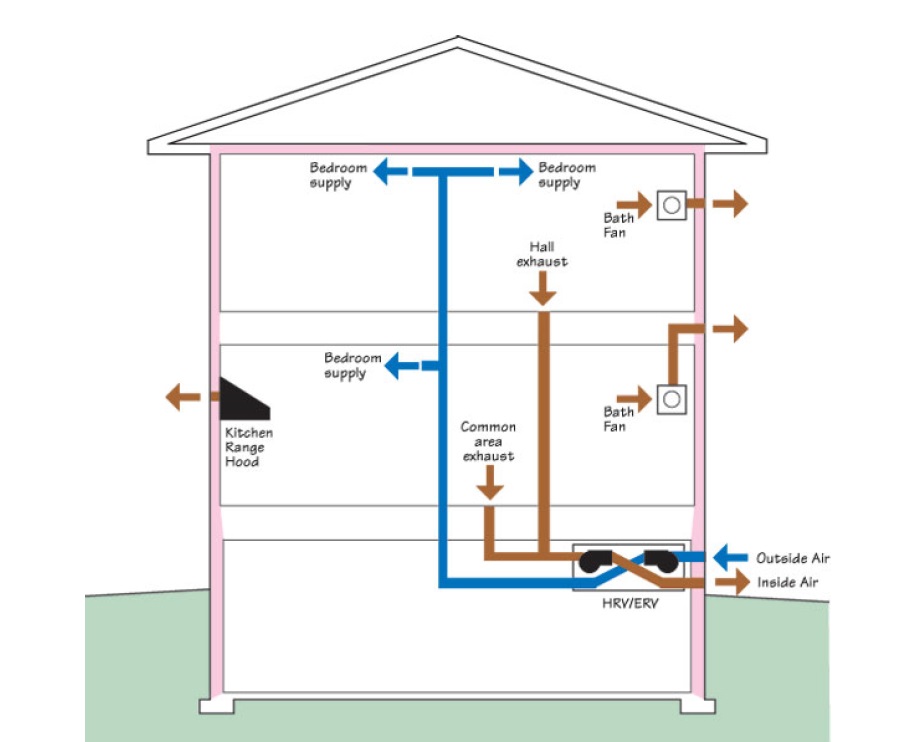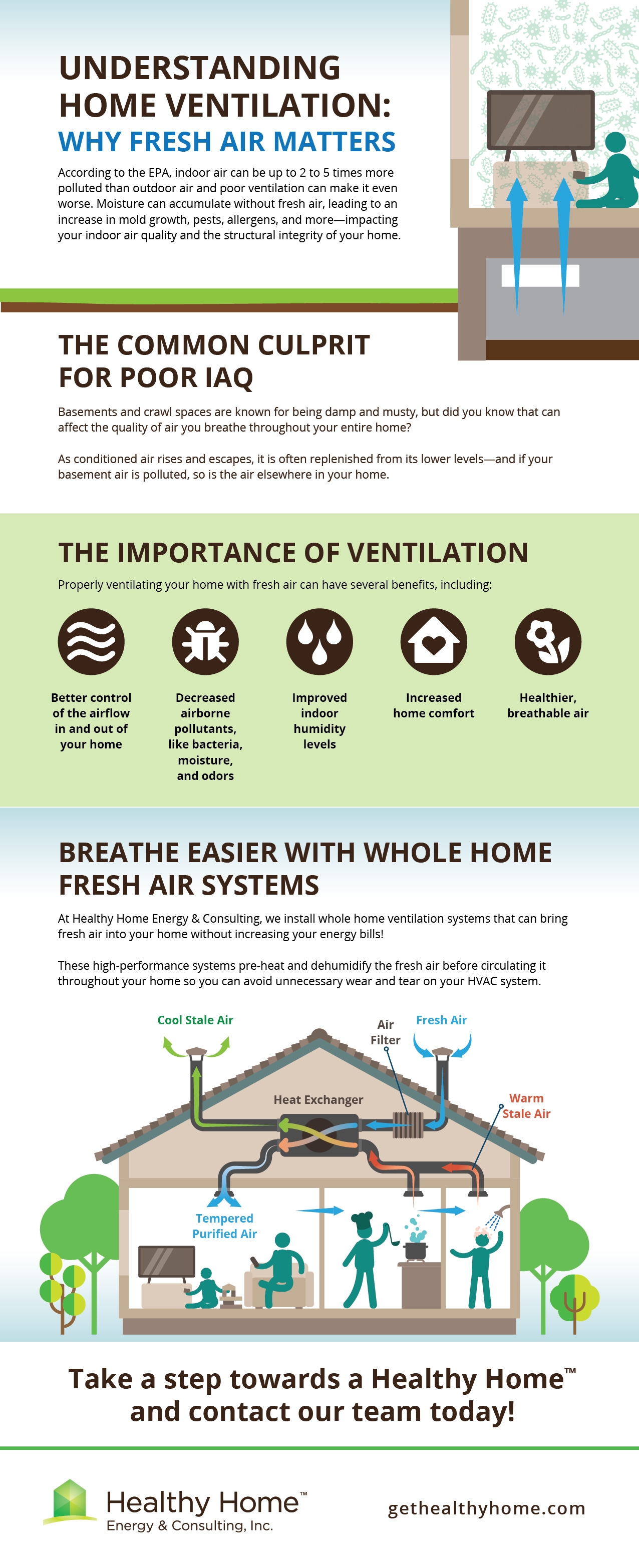Recognizing the Significance of Home Air Flow for a Healthier Living Atmosphere
Home air flow plays a necessary role in maintaining a healthy and balanced living setting. It facilitates the exchange of interior and exterior air, which is very important for enhancing air top quality. Without correct ventilation, homes can come to be reproducing premises for irritants and contaminants. The consequences of insufficient air circulation can be significant. This brings up the questions of just how property owners can effectively apply air flow methods to protect their health and wellness. Understanding these methods is essential.

The Essentials of Home Ventilation
Home ventilation functions as an important component of interior air top quality and convenience. It entails the process of exchanging stale interior air with fresh exterior air, consequently minimizing humidity and managing temperature level. Correct air flow systems can consist of all-natural techniques, such as open windows and vents, in addition to mechanical systems, such as exhaust followers and air exchangers. Efficient home air flow helps protect against concerns like interior mold development and the buildup of dangerous particles. It also boosts general energy efficiency, as well-ventilated areas can maintain comfortable temperature levels with much less dependence on heating and cooling systems. Recognizing the essentials of home air flow is vital for home owners looking for to create a healthier living setting for themselves and their families.

Usual Sources of Indoor Air Contamination

Although numerous might not realize it, indoor air contamination can originate from various resources within a household. Common contributors include unstable natural compounds (VOCs) discharged from paints, solvents, and cleaning products. Home appliances, such as gas stoves and fire places, can launch harmful gases like carbon monoxide and nitrogen dioxide. Additionally, mold and mildew and mold grow in moist locations, releasing spores that influence air high quality. Animal dander, dirt mites, and pollen can gather inside, additional aggravating pollution levels. Smoking cigarettes inside your home creates hazardous chemicals that linger in the air. Constructing materials, consisting of asbestos and formaldehyde, can off-gas hazardous substances. Recognizing these resources is vital for keeping a much healthier indoor environment and promoting effective air flow techniques.
Health And Wellness Results of Poor Ventilation
Indoor air pollution can have substantial health and wellness implications, particularly when ventilation is poor. Poor ventilation can bring about the buildup of hazardous toxins, such as unpredictable organic substances, mold, and particulate issue. This accumulation may cause respiratory system issues, including bronchial asthma, allergies, and persistent obstructive pulmonary condition. People may experience signs like migraines, fatigue, and irritability of the eyes, nose, and throat. Vulnerable populations, such as youngsters and the elderly, are at greater threat for extreme health effects. Lasting exposure to poorly ventilated settings can likewise contribute to extra major conditions, including heart diseases. Making certain proper air flow is necessary for keeping a healthy and balanced living setting and minimizing the threat of health complications linked with interior air pollution.
Reliable Air Flow Techniques for Your Home
Appropriate ventilation is crucial for maintaining a healthy indoor setting, and carrying out reliable approaches can considerably enhance air high quality. Homeowners can start by guaranteeing that exhaust fans are set up in bathroom and kitchens to eliminate excess dampness and smells. Opening up windows regularly enables fresh air to flow, especially throughout light weather condition. Additionally, making use of air cleansers with HEPA filters can help capture airborne pollutants. For homes with heating and cooling systems, preserving cooling and heating systems and altering filters regularly is essential for peak efficiency. Incorporating natural air flow strategies, such as cross-ventilation, can additionally improve airflow. Lastly, securing any type of leaks in home windows and doors stops undesirable drafts, which can website here interrupt controlled air movement, ultimately bring about boosted indoor air top quality and convenience.
Maintaining Optimal Air Quality Year-Round
To maintain ideal air top quality year-round, property owners must take on a positive technique to managing their indoor setting. Regularly checking indoor air high quality is vital; this includes monitoring for toxins such as dust, mold, and volatile organic substances (VOCs) Executing efficient air flow systems, such as exhaust followers and air cleansers, can considerably decrease airborne contaminants. Furthermore, routine maintenance of heating and cooling systems assurances peak efficiency and air circulation. House owners need to likewise take into consideration moisture degrees, as extreme moisture can bring about mold development. Seasonal modifications might demand modifications in ventilation approaches to accommodate differing exterior air quality. By prioritizing these techniques, house owners can create a healthier home, advertising general wellness for all owners throughout the year.
Often Asked Inquiries
How Can I Tell if My Home Needs Much Better Ventilation?
To determine if a home requires far better ventilation, one must observe indicators such as relentless humidity, mold development, moldy odors, condensation on home windows, or enhanced allergic reaction signs, showing inadequate air flow and potentially poor indoor air high quality.
What Are the Indicators of Poor Indoor Air Top Quality?

Can Houseplants Improve Indoor Air High Quality Effectively?
The performance of houseplants in boosting interior air top quality is questioned. While some research studies suggest they can absorb toxic substances and click resources generate oxygen, their total influence may be very little contrasted to proper ventilation and air purification systems.
Just how Often Should I Adjustment My Air Filters?
The frequency of air filter changes typically depends upon usage and filter kind. Generally, it is advised to replace filters every three months, though families with allergic reactions or family pets might call for more frequent adjustments for optimal performance.
Exist Any Kind Of Specific Air Flow Equipments for Allergic Reaction Sufferers?
Numerous ventilation systems, such as HEPA-filtered devices, successfully minimize allergens in the air. Home Ventilation Melbourne. These systems trap dirt, pet dog, and plant pollen dander, offering allergy victims with a cleaner, much healthier indoor environment while handling air top quality successfully
It facilitates the exchange of interior and outside air, which is important for enhancing air high quality. Home ventilation serves as a read more necessary part of interior air top quality and comfort. It involves the procedure of exchanging stagnant indoor air with fresh exterior air, thereby decreasing humidity and regulating temperature level. Interior air contamination can have considerable wellness effects, specifically when air flow is inadequate. Proper air flow is essential for preserving a healthy and balanced indoor setting, and applying effective strategies can substantially improve air top quality.